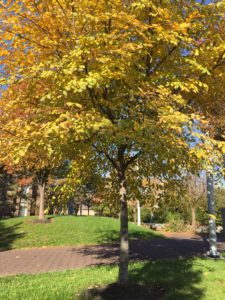
Do you ever look up and wonder, why does that tree still have green leaves when that tree is turning yellow or that tree over there has already lost all of it’s leaves? Some say it’s about the heat. Some say it’s the amount of water, I say…it’s a mixture of it all. Let’s break it down.
Which plants do it? All plants that drop their leaves in the winter, aka deciduous plants will have some sort fo fall color. Sometimes it is nothing more than a muddy brown and other times it is a bright red and oranges. Evergreen plants have adapted super hardy leaves that can withstand freezing temperatures so they do not need to drop leaves.
What is it? Fall color comes from pigments in the leaf that are unmasked once the trees stops producing and breaks down chlorophyll. Carotenoids are responsible for the orange and yellows and Anthocyanin is gives us the reds.
Why do they do it? Leaves are highly porous and exchange a lot of water while photosynthesizing during summer months. If the leaves didn’t fall, they would freeze, and the freezing would continue into the tree and cause damage. Instead, plants proactively seal the leaves off at the stem to protect from winter conditions.
When does it happen? Trees sense autumn by the lack of daylight, specifically how long the night is. It is not based on temperature or precipitation. Once nights become long enough a series of responses are triggered and the tree starts to cut off sugar production in the leaves and seal them off.
How does weather affect it? Warm sunny days, cool nights and ample moistures create low stressed leaves with higher amounts of anthocyanin and longer lasting carotenoids. This combination of weather gives us great fall colors. If the trees experience dry conditions or a lack of sun pigment concentrations are lower creating duller leaf colors. Freezing and windy conditions might force the leaves off the tree sooner creating a short season of fall color.
Take a walk on the Trail and let us know what you see/experience. We’re social, @IndyCulturalTrail!